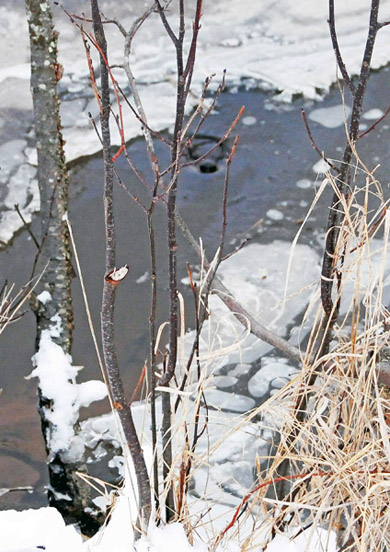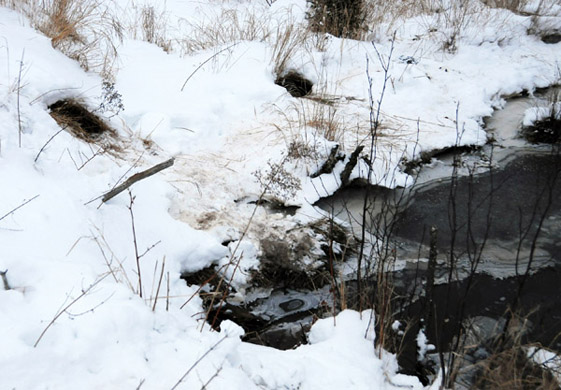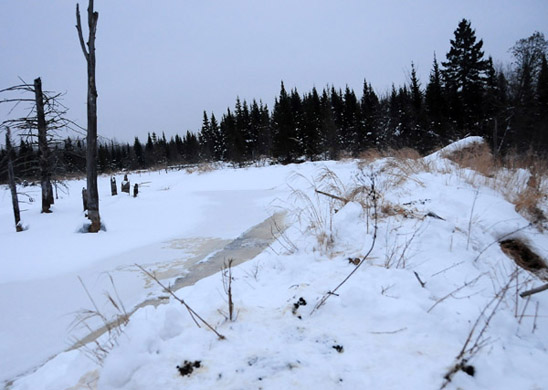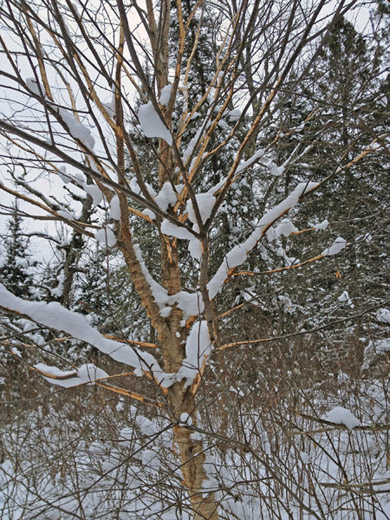LAST UPDATED: May 1st, 2015
CAYUGA, Wis. – The sun was nestling into the tops of tall spruce and magnum poplars in mid-February as I snowshoed across a beaver dam south of Tom Heberlein’s shack in the Chequamegon National Forest in far northwestern Wisconsin. That meant my camera’s shooting light was fading fast. I’d have to hurry to snap a few photos of the otter dens bordering the beaver’s long-abandoned dam and ice-covered flowage. The dam’s south-facing slope also held several otter slides, their glazed chutes ending in the ice-rimmed creek below. Tim Watson and I noticed the dens and slides the day before while retrieving gear left behind during our early December deer hunt. Watson and I had returned to the shack all these weeks later with our wives, Karen and Penny, for our group’s eighth annual snowshoeing getaway.
After Watson and I crossed the dam, we noticed long half-pipe otter trails weaving through the snow-covered beaver meadow south of the dam. Although otters are most noted for water acrobatics and torpedo-like swimming routines, they’ll often dash cross-country, pressing the snow along their paths into long, white troughs. Now I was back on the dam, alone this time, squeezing in a final trip to the frozen flowage before spending a final night in the shack, laughing and telling stories while sharing food and drink with our good friends.
An otter pokes its eyes above icy water in a creek below a beaver dam in Wisconsin’s Chequamegon National Forest near the small town of Cayuga.
I paused atop the dam at its weakest point. This is where the beaver’s work is decaying, loosing relentless torrents into the creek below. The otters had also paused near here on several occasions, judging by the black poop littering the dam’s crest. Water splashed and gurgled below my snowshoes as I snapped photos of the dam and its white-shrouded flowage. Despite the pleasant sounds, I had no trouble hearing something approaching from around a creek bend about 20 yards away. I turned to watch and listen as powerful, watery surges crinkled the thin ice rimming open pools, and strained the thicker ice bordering the banks. As the sounds grew louder, a blur of black velvet sluiced beneath the ice 10 yards away and silently vanished. Then, just as I thought it had disappeared into some deep, unseen pool, a dark, shimmering softball with a whiskered snout popped from the water five yards away, black eyes glistening in the gloaming.
Two otter dens border this creek in far northwestern Wisconsin.
I was too late focusing the camera. The otter dropped from sight as if falling through a trapdoor and shot downstream beneath the ice. About a minute later, I heard it returning, its progress marked once more by crinkling and groaning ice. It wasn’t as bold when rising to inspect me a second time. This time all I saw was its forehead, eyes and upper snout. It vanished again when the camera’s shutter snapped. The otter was more cautious yet when returning upstream a third time. This time it hugged the banks, occasionally rising unseen beneath overhangs to softly growl. Or maybe it was just breathing heavily after this prolonged exertion. When it disappeared downstream again and didn’t return, I hurried eastward to quickly scout some high ground for deer sign. Then, with daylight nearly gone, I re-crossed the beaver dam and headed north to the shack.
Otters often rest and play on this beaver dam, lounging atop it when resting, and then sliding down its banks into the creek below.
The otter capped a great day that had begun 11 hours earlier with a solo trip at dawn to retrieve gear from three deer stands Watson and I hadn’t reached the day before. As I set out that morning, Penny cautioned me to be careful, and promised to hold breakfast till my return. I patted my pockets to ensure I brought my compass, GPS unit and iPhone, just in case. After a half-mile tromp to the site we call “TJ’s Stand,” I extracted an ice-covered cushion from beneath the snow, tied it to my pack and skidded down a hillside to snowshoe for “Peter’s Stand” about a quarter-mile away. I stopped in the flat below when gnawed branches on a young yellow birch caught my eye.
A hungry porcupine gnawed nearly all the bark from this yellow birch in Wisconsin’s Chequamegon National Forest.
The gnawing’s were about four feet above the snow-pack, so I first assumed a snowshoe hare had reached them from a since-melted snowdrift. When I looked higher up the birch, however, I saw the bark on nearly every branch was gnawed far up its length, some nearly 15 feet above the ground. What the …? No hare did that. My suspicions shifted from hares to porkies; porcupine, that is, as in “quill-pig,” Wisconsin’s second largest rodent after the beaver. Their low-protein winter diet consists of buds, conifer needles, and the bark of pines, birch, hemlocks and maples. Judging by the raw gnawing’s, the porcupine might still be visiting this birch on feeding waddles. Maybe so, but the snow nearby showed no such evidence. The area had received a fresh 2-inch coating the day before, but no tracks or droppings yet blemished the surface, and no snow-tunnel openings were visible nearby. The porkie had probably moved on, searching for more productive trees to pillage.
I moved on as well. I had two more stops to make before breakfast, and my stomach was already growling.

 By
By 







